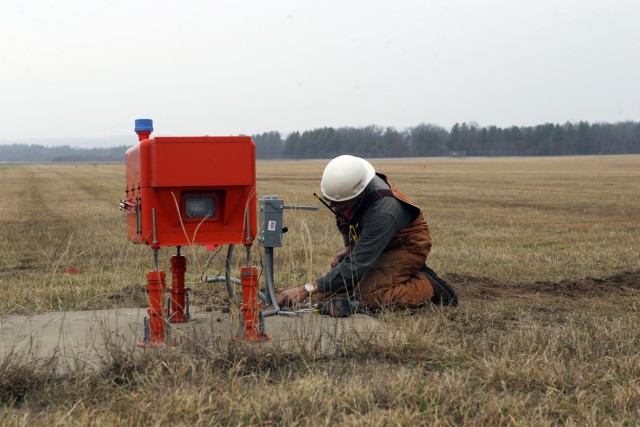Improved runway lighting and signage will make it easier and safer for aircraft taking off and landing at the joint-use Sparta-Fort McCoy Airport. A new fence project also improves perimeter security and provides protection against wildlife encounters with the aircraft.
James Hubbard, Directorate of Plans, Training, Mobilization and Security (DPTMS) Air Traffic Control Tower chief, said the Pieper Power Company of Milwaukee completed the lighting project.
The replacement lighting upgrades the system from incandescent to quartz lighting. "The quartz lights are brighter and will better support pilots' vision and capability to land," Hubbard said.
Another feature of the upgraded lighting system is the pulsating light approach slope indicator equipment, he said.
"The lights will flash red or white, which will tell pilots if their approach height or glide path is too high or too low," he said.
Randy Willer, DPTMS Airport manager, said the new lighting system also includes a concrete-type mound enclosure, which makes the system easier to maintain.
Access to the lighting system to make repairs can be gained by removing the top of the structure. The previous lighting regulators were buried in the ground, which meant the lighting regulators had to be dug up to make repairs and could lead to further damage of the system.
"The new lighting system also includes a new backup generator and the capability to expand the system, which would support future military and civilian uses and missions," Willer said. "Pilots use their radios to turn on the new lighting system. The lighting automatically shuts off 15 minutes after an aircraft lands."
These features will help save energy and costs, as well, he said.
A new, lighted signage system also was installed, Willer said. Military and civilian pilots use the same runway to land and take off, so the signage helps pilots better differentiate between the military and civilian operations portion, of the joint-use airport.
Hubbard said the new signage also includes distance signs, which help pilots gauge where they are at on the runway/taxiways.
These improvements will better support night landings and take offs, and make them safer, for both military and civilian aircraft, thus expanding the airport's operational capabilities, Willer said.
A separate project included the installation of a new security fence around the airport, which also will help keep wildlife, including deer, away from the runway, taxi and operations areas, he said.
This will improve safety, Willer said.
Fort McCoy budget funds paid for the lighting and signage project. The fence was paid for with a combination of city, state and Federal Aviation Administration funds.


Social Sharing